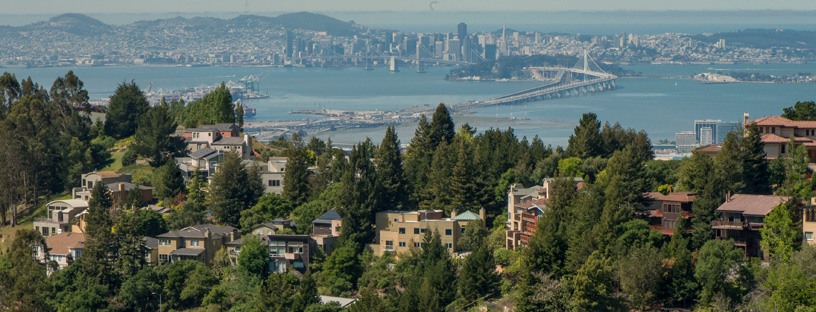The Air District has fined Martinez Refining Company, or MRC, and has required MRC to significantly enhance transparency for air monitoring data for air pollutants around its refinery in Martinez
-
About the Air District
- Advisory Council
- Air District Leadership
- Air District Logos
- Bay Area Clean Air Foundation
- Board of Directors
- Community Advisory Council
- Contracting Opportunities
- Departments
- Diversity Equity and Inclusion
- Enterprise Systems Catalog
- Hearing Board
- History of Air District
- In Your Community
- Job Opportunities
- Mission Statement
- Office of Civil Rights
- Speakers and Tours
- News & Events
- Online Services
- Publications
- Forms
- Public Records
- Contact Us
- Login
Alameda County

Learn about Alameda County - its climate, potential air pollution concerns, and current air quality. You can also view upcoming Air District events in Alameda County and read about local efforts to improve air quality.
Alameda County lies east of the San Francisco Bay, bounded by Contra Costa Bay to the north, San Joaquin County to the east, and Santa Clara County to the south. Four representatives sit on the Air District’s Board of Directors.
-
-
Air District fines Chevron $900,000 for air monitoring violationsDecember 02, 2025
The Air District has fined Chevron $900,000 for failing to properly monitor air pollution emissions at its refinery in Richmond.
Learn More -
Spare the Air Alerts issued for Wednesday & Thanksgiving Day due to wood smoke pollution. Use of all wood-burning devices is prohibited.November 25, 2025
The Air District is issuing the winter season’s first Spare the Air Alerts for Wednesday, November 26, and Thanksgiving Day, which bans burning wood, manufactured fire logs or any other solid fuel, both indoors and outdoors.
Learn More -
Public Comment Deadline – Draft Local Community Benefits Fund Guidelines (Nov 25 at 5 PM)November 19, 2025
The public comment period for the Draft Guidelines for the Local Community Benefits Fund for Benicia, Richmond, and surrounding areas closes on Tuesday, November 25, at 5:00 PM. The Draft Guidelines describe the Local Community Benefits Fund, which will reinvest penalty funds back into communities impacted by air quality violations, supporting local projects that improve public health, reduce pollution, and promote a just transition.
Learn More -
-
-
Upcoming Events
-
DEC302025
-
10/28/2025 Air District fines Republic Services $159,000 for landfill gas violations
October 28, 2025
-
10/27/2025 Air District issues prescribed burn notice for October 27-31
October 27, 2025
-
10/22/2025 Air District awards $5M to electrify special education school buses
October 22, 2025
-
10/17/2025 Air District issues prescribed burn notice for October 17 - 24, 2025
October 17, 2025
-
10/9/2025 Air District fines Marathon Martinez Refinery $372,550 for violations
October 9, 2025
-
10/1/2025 Air District Board adopts wood burning and prescribed burning amendments to protect public health and reduce wildfire risk
October 1, 2025
-
9/27/2025 Air District issues air quality advisory for wildfire smoke through Sunday
September 27, 2025
-
9/25/2025 Air District receives first finance award for excellence in budget process
September 25, 2025
-
9/22/2025 Air District issues Spare the Air Alert for Tuesday
September 22, 2025
-
9/15/2025 Air District awards $1.18 million to San Ramon Valley Unified School District for new EV school buses, charging infrastructure
September 15, 2025
-
9/11/2025 Air District opens Clean Cars for All program with $10 million in funding
September 11, 2025
-
9/10/2025 Air District strengthens leadership team, staffing to deliver on permitting priorities & strategic goals
September 10, 2025
-
9/2/2025 Air District fines Chemtrade West US LLC $160,000 for air quality violations
September 2, 2025
-
8/26/2025 Air District lifts air quality advisory for wildfire smoke
August 26, 2025
Climate
Along the county’s western coast, temperatures are moderated by the bay, which can act as a heat source during cold weather, or cool the air by evaporation during warm weather. It is generally sunnier farther from the coast, although partly cloudy skies are common throughout the summer. Average summer temperatures are mild overnight and moderate during the day. Winter temperatures are cool overnight and mild during the day. Highest temperatures are more common inland. Wind speeds vary throughout the county, with the strongest gusts along the western coast, often aided by dominant westerly winds and a bay-breeze effect. Rainfall totals average about 14 to 23 inches per year, with the highest totals in the northern end of the county and atop the Oakland-Berkeley hills.
Interactive Air Monitoring Stations Map
Air Quality in Alameda County
Ozone and fine particle pollution, or PM2.5, are the major regional air pollutants of concern in the San Francisco Bay Area. Ozone is primarily a problem in the summer, and fine particle pollution in the winter.
In Alameda County west of the East Bay hills, ozone rarely exceeds health standards because the area is adjacent to San Francisco Bay, which tends to keep temperatures well below prime levels for ozone formation. PM2.5 is a more significant issue in this region due to cool winter nights with light winds, wood smoke, and occasional pollution transport from the Livermore Valley to the east.
Eastern Alameda County has the highest ozone levels in the Bay Area, with summer afternoon temperatures frequently approaching triple digits, spurring ozone levels to exceed health standards. In winter, PM2.5 can be transported westward through the Altamont Pass from the Central Valley where it adds to wood smoke levels, causing health standards to be exceeded.
Last Updated: 4/21/2017

